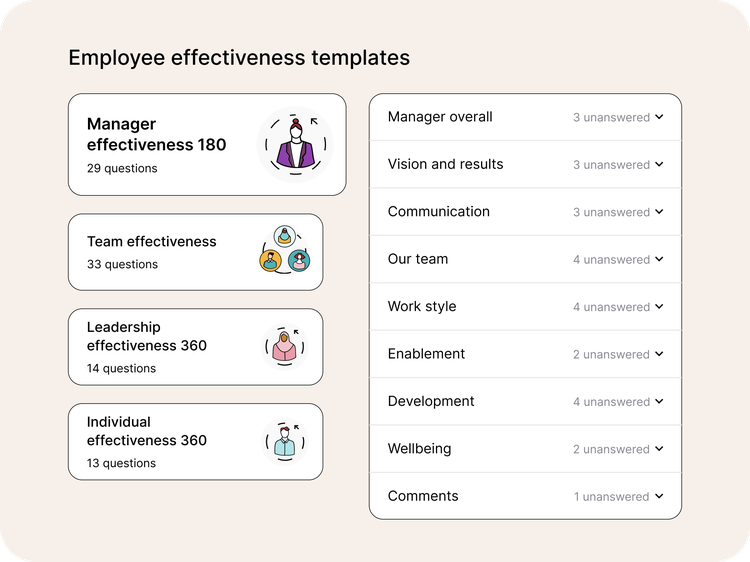
How to build and develop high-performing teams

Written by

Director of People Science Research, Culture Amp
The way we work and the nature of work is changing. Historically, organizations were developed to optimize for efficiency. However, this was only possible because back then work was predictable. With the rise of new technological innovations, the rate of change in business has accelerated.
In this new world, optimizing for efficiency is being traded out in favor of adaptability and agility. One way companies are making this shift is through organizational design, specifically restructuring around teams. We'll look at why teams are becoming more popular and how to support teams at work.
However, not every group will be a team, and not every team will be high performing. Therefore, after discussing the data behind teams-based models, we examine how to best build high-performing teams, what you can expect, and how to provide ongoing support for those teams.
Why build networks of empowered teams?
In 2016, Deloitte found redesigning organizations around teams to be the number one human capital trend, with 92% of companies believing it was very important or important. The following year, re-organization was again the number one trend.
This reasonably recent drive to restructure around teams is for good reason. Teams have been shown to perform better on complex problem-solving than the best of an equivalent number of individuals.
In fact, Deloitte’s 2019 trends suggest that “shifting toward a team-based organizational model improves performance, often significantly.” 53% of respondents stated that they had experienced a significant improvement in performance since transitioning to a team/network-based organization. Clearly, teams (when created effectively) get the work done and perform at a high level.
How to choose members for high performing teams
If you’re ready to get a slice of the high-performance pie, let’s consider how to construct high-performing teams. The amount of research on this is staggering. The Oxford Review found that "over 8,100 peer-reviewed research papers directly look at high-performance teams.”
Some used to believe that creating an all-star super team simply meant assembling a group of star performers. However, they soon found this didn’t work. That’s because how team members interact with each other often matters just as much as their intellect.
The truth is that no one has the secret for creating a cookie-cutter high performing team. However, research has helped to narrow down key indicators.
In 2010, academics from MIT, Carnegie Mellon, and Union College tested 192 groups. They found that the main predictors of team success are “social sensitivity, the distribution of conversational turn-taking, and the proportion of female group members.” In other words:
- Socially sensitive groups were more successful. These teams were better at reading the emotions of others by non-verbal cues and could empathize with them and their viewpoint.
- Groups in which members took turns to talk were collectively more intelligent than groups where a few people dominated the conversation. Thus, whether all team members share in conversation and discussions indicates a higher intellect team.
- The proportion of females in the group was positively correlated with the group's collective intelligence, likely because women also scored higher on social sensitivity.
The study concluded, “Collective intelligence appears to be only moderately correlated with individual group members’ intelligence. The results hold regardless of group size."
Thus, when choosing members for your next team, it’s worth considering those with high emotional intelligence (the ability to understand and manage emotions in an effective way). Emotional intelligence may be as important (if not more important) to consider as traditional intellect.
Four development stages of high-performing teams
Once your team members are lined up, it’s time to bring everyone together. Although you will have invested some time into getting to this stage, don’t expect it to take off like a shot. These things take time. Even if you’ve chosen the right people, a new team won’t start working to its full potential on day one.
Thankfully, due to yet more research, there is a theory for understanding the evolution of high-performance teams. In the 1960s, psychology researcher Dr. Bruce Tuckman developed a four-step model for team evolution, which others have since iterated. This will help you track the development of your team and give a window into what to expect.
1. Forming
During this stage, people are simply trying to get to know each other. Even if they’ve met before, they may not have worked closely or on the same team. Thus, most people will be polite or perhaps nervous. They may have their walls up as trust is yet to develop. During the forming stage, the team leader will play a heavier role in guiding the group, outlining expectations, and encouraging everyone to get to know each other.
2. Storming
This is generally the rocky stage in which team members face challenges or conflicts within the group. It’s also the stage at which most teams fail.
Conflict can be for numerous reasons, such as members having different working styles or members vying for a position. Whatever the reason, it’s important for the team leader to coach the team and individuals through this stage and how to manage their issues. When resolving conflict, it's important to create rules of engagement or ways of working that everyone in the team feels good about.
3. Norming
Once the team has settled down into their roles and the conflict has been resolved, the magic begins to happen. Members have learned more about each other and started working well together. There is more collaboration and constructive feedback.
At this point, the role of the team leader will most likely be cemented and respected. There should be less need for hands-on guidance, with simple facilitation occurring. Though, of course, HR should be on hand to help. It’s possible (if not probable) for the Storming and Norming phases to overlap as new projects bring fresh challenges to different team members. HR assistance should help to smooth this out.
4. Performing
At this stage, the team is “crushing it.” Members can manage their relationships and should feel psychologically safe within the group. They’re able to communicate openly with each other and the leader. Furthermore, everyone is working together toward common goals. There is a real sense of purpose and team identity. As for the role of a leader, it has genuinely shifted. There is more delegation of work to individuals, a focus on upcoming team goals, and the development of team members.
In 1977, adjourning was added as a fifth stage. This stage refers to when the group breaks up after completing a task.
How to provide meaningful support and empower teams at work
While some of you may be bolstered by this point and excited to try out a new team model, others may be apprehensive. That’s understandable. Although many companies have successfully moved to a team-based model, some have struggled. There seem to be just as many articles online that shun the teams-based model as those that recommend it.
Even in Deloitte’s 2019 trends, 25% of respondents have experienced a neutral, negative, or unrecognizable impact from transitioning to a team/network-based organization. One reason for this might be that despite the rising number of teams at work, organizational support systems haven’t changed. Most companies are still focusing their attention and centering their programs around individuals, even after they restructure to teams.
Consider compensation at your organization. It’s likely based on an individual’s contributions in the form of an hourly wage, tips, salary, or sales commissions. It may also be informed by a periodic performance review based on individual goals. When we think about learning and development, it’s the same story. We train people through programs aimed at the individual, and we focus on developmental feedback primarily through individual 360 surveys or coaching.
To create better-performing teams, consider experimenting with the following ideas at your organization to enable teamwork.
1. Develop goals at the team level
Companies with organizational-level goals and objectives are at an advantage because teams can use them as their north star. In addition to organization and individual goals, consider setting team-level goals. A meta-analysis in 2011 found that setting team goals is associated with better team performance. There’s also preliminary evidence in a sports context that setting goals as a team can lead to higher team cohesion.
It's important to also highlight that a key step is to engage team members in the goal-setting process (rather than simply assigning goals to teams). This involvement can increase buy-in and ownership.
2. Provide feedback on team goal performance
When it comes to feedback on performance, similar to developmental feedback, it's often provided only at the individual or organizational level. According to a study by DeShon and colleagues at Michigan State University, this is missing a huge opportunity, as feedback generally leads to improved performance on what the feedback was directed towards.
When feedback on individual performance was given, individual performance improved. When feedback on team performance was given, team performance improved. In short, if you want to enable teamwork and performance, provide feedback at the team level. The level at which you provide feedback is a shortcut for employees to determine what is important to your organization.
3. Factor team performance into rewards
When you reward your employees, experiment with factoring in their team's performance. In 2014, Garbers & Konradt analyzed almost 150 studies and found that team-based rewards had a larger impact on performance than individual incentives, especially if the rewards were distributed equitably. However, there were team composition factors that affected the impact of the rewards, including team size and gender composition. Therefore, the context of the team should be considered as well.
4. Provide training in teams
There is an opportunity to train employees to work better in teams. Individual development is still important, but it will not always improve how people work together as a team. A 2008 meta-analysis found that team training is associated with better team performance, affective outcomes (such as trust), and team processes (such as communication and decision-making). Training in a team context versus individual training is associated with greater training recall and team performance.
5. Identify the unique needs of the teams in your organization

While the suggestions above are general ways to unlock the potential of teams, every organization will have unique challenges. A team effectiveness survey is a great way to understand what your teams are experiencing and to give them feedback that they can use to develop. From the organizational level, results can be used to identify if opportunities are similar across your teams, indicating that the organization may not be enabling that teamwork component. For example, if your teams score low on “If someone makes a mistake, they admit it to the team,” you might want to consider promoting an organizational culture that views failure as a learning opportunity.
Supporting teamwork over time
If you want to ensure the success of shifting to a teams based model, research and dedication are required. It’s not as simple as just changing lines on the company hierarchy. Take the time to choose the right people, nurture the team’s development, and support them if anything goes awry. Do that, and you’re setting yourself up for success.


